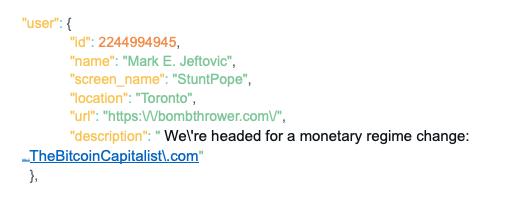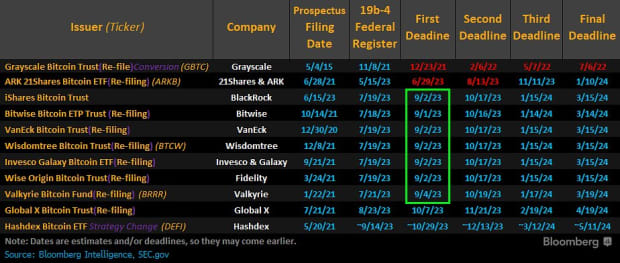That is an opinion editorial via Mark Jeftovic, cofounder and CEO of easyDNS Applied sciences Inc. and creator of “Managing Challenge Crucial Domain names and DNS.”
From the instant I came upon Bitcoin again in 2013, I knew there would ultimately need to be a approach to reference pockets addresses the usage of human-readable labels.
The large downside with Bitcoin’s lengthy addresses is that they aren’t memorable, and regardless of the pseudonymous or nameless options of Bitcoin, numerous the time you need as a way to simply assert or check {that a} pockets deal with belongs to a selected entity — suppose donations to a charity or a crowdfund. This impacts each blockchain.
As a DNS (area title machine) man, I’ve noticed this film ahead of: DNS used to be invented to unravel the similar downside with IPv4 addressing. Over the years DNS developed to do a lot more — now not handiest did DNS upload the aptitude to unravel IPv6 addresses, however additionally it is an increasing number of used to put across metadata a couple of namespace. Assume SRV records, NAPTR’s, RBL blocklists, response policy zones (RPZs) and the ubiquitous TXT record (which is used for SPF, DMARC, DKIM and anything that doesn’t natively have compatibility the protocol).
Alongside comes Bitcoin and we now have the similar downside, writ massive.
The Drawback Particular To Bitcoin And Lightning
It’s taking a look like a lot of the cost transaction task will transfer to Layer 2 with protocols like Lightning, and maximum not too long ago the arrival of the Lightning Address.
Lightning Addresses depend on the LNURL-pay protocol, and so they glance beautiful similar to an electronic mail deal with:
The e-mail deal with nomenclature is the easiest approach to put across identification data. It simply demarcates organizations and additional subdivides to gadgets or other folks inside it. Everyone is already used to this layout and as we’ll see, has the possible to put across a lot more data than vacation spot mailboxes.
For years I used to be expecting this layout changing into the de facto usual for identification endpoints with Session Initiation Protocol (SIP) and XMPP.
SIP and XMPP didn’t take over the sector somewhat the way in which I anticipated them to (a minimum of now not but) and for some time, identifiers began gravitating towards centralized platforms like Twitter handles and Github consumer IDs. I all the time discovered this quizzical, particularly amongst Bitcoiners.
With Lightning Addresses we see a trail again towards decentralized identifiers, since electronic mail addresses are themselves decentralized, inside the limits of the DNS machine itself (extra on that under).
There’s just one downside: the LNURL spec as outlined is lacking a degree of abstraction. With out it, the use case for Lighting fixtures Addresses turns into very constrained.
Given the Lightning Deal with:
satoshi@instance.com
That implies beneath the present specification, the cost descriptor can be positioned at:
https://instance.com/.well known/lnurlp/satoshi/
However what if Satoshi doesn’t have get admission to to the instance.com webserver? If we keep on with the e-mail deal with analogy: simply because you could have this as your deal with doesn’t imply the server with the matching hostname is the place the e-mail will get delivered.
If truth be told that’s most definitely now not the case extra ceaselessly than it’s. Because of this there exists the MX report kind in DNS, which provides an additional point of indirection to regulate the vacation spot for electronic mail. They are going to direct electronic mail supply to hostnames working beneath a fully other area title (take into accounts individuals who use an exterior electronic mail supplier, however with their very own customized area).
The similar factor must occur with Lightning Addresses for in large part the similar causes. The hostname to the best of the ‘@’ would possibly not have a webserver in any respect, or the consumer is unduly confined to the usage of a Lightning Deal with the place the hostname element can handiest be that of the webserver the place the JSON document is hosted. That may be an issue when publishing a Lightning Deal with that the consumer needs to modify down the street.
As a DNS man, the answer appeared glaring however I used to be in charge of overthinking it:
In 2017 I used to be invited via what used to be then the Ethereum Title Provider Running Crew to a gathering in London to figure out the specification for the ENS registry.
I left that assembly pondering that there must be a brand new DNS useful resource report, a brand new report kind that may have the ability to reference blockchain sources from inside the legacy DNS.
In my thoughts it will glance one thing like a SRV or NAPTR report, which had other fields for protocols, ports and weightings (the truth that internet browsers as of late nonetheless don’t have a look at SRV information for internet addresses is among the nice ignored alternatives of the web age).
My running shorthand for it used to be “BCPTR” for “Blockchain Pointer” and it had an overcomplicated, convoluted specification for mentioning precisely which blockchain a report used to be pointing at and what form of useful resource it used to be.
Then within the Lightning GitHub factor, the place the LNURL RFC used to be being mentioned, anyone suggested simply prepending an address with the “_lud16” subdomain.
The use of underscores to distinguish sure naming attributes from exact hostnames has been round for awhile. It used to be used within the unique SRV RR spec RFC2872 and later described as “underscore scoping” in RFC 8552.
The advice instantly exploded in my mind and I spotted that I have been overthinking this for years.
A scoped label in DNS, like _tcp or _udp, are case insensitive and we see them in SRV and NAPTR information to be used in SIP, VOIP and ENUM programs, load balancing, to not point out in TXT information for DKIM and DomainKeys.
Lovely neatly any legitimate DNS label, like _lud16 or _btc, supplies us with a mechanism to restrict a reaction to a question matching the scope, beneath the mother or father node within the DNS tree.
That means:
$ORIGIN instance.com.
_ie.check IN TXT “this can be a check”_eg.check IN TXT “this can be a separate check”
A DNS question for kind TXT on “check.instance.com” won’t go back a solution (NXDOMAIN).
A DNS question for kind TXT on “_ie.check.instance.com” will handiest go back a end result for the primary report.
A DNS question for kind TXT on “check._ie.instance.com” will handiest go back the second one report.
In different phrases, we now have a couple of TXT information for the check.instance.com leaf, then again, we can handiest go back the only queried with the scoped label, the person who starts with an underscore.
It seems that is somewhat tough for our functions. Additionally it is the very best, optimum resolution in our use case as a result of:
- Everyone can use it.
- It’s a layout other folks simply acknowledge.
- It may be retrofitted onto any current electronic mail deal with by means of DNS.
- It supplies the facility for a json report to exist somewhere as opposed to the server (like how an MX report purposes).
- Can give any more or less payload.
- Can paintings throughout all blockchains.
How Underscore Scoping May just Be Used In Blockchains
Via taking the e-mail deal with layout utilized in Lightning Addresses: , we will be able to use the conference by means of the DNS to specify a wide variety of endpoints for a similar identification:
$ORIGIN bombthrower.com.
_lud16.markjr IN TXT “https://my.ln-node/.well-known/lnurlp/markjr“
_btc.markjr IN TXT “bc1qu059yx6ygg9e6tgedktlsndm56jrckyf3waszl”
_ens.markjr IN TXT “0xEbE7CcC5A0D656AD3A153AFA3d543160B2E9EdFb”
We will get there from right here with out breaking the rest already in position:
- Programs already the usage of LNURL deal with can all the time stay the usage of that
- Programs can upload the DNS search for
However DNS Is Centralized!
It’s true that DNS has an inverted tree construction that terminates on the root “.”. However even that root is relatively decentralized, comprising 1000’s of servers operated via a minimum of 13 disparate operators. The legacy DNS is also logically centralized however in fact purposes extra like a decentralized federation of types.
Even that is converting, evolving. I feel the place we ultimately finally end up is the place namespaces straddle each the present inverted tree root and completely decentralized blockchains.
A few of that is already right here as of late: you need to use one thing like Stacks and .btc domains which pins to Bitcoin and there it is going to be different namespaces constructed immediately atop Bitcoin.
Now not all decentralized namespaces have legacy DNS resolvers, however that can exchange too. There may be paintings being finished on a brand new DNSresolvers implementation which can unravel Stacks, .btc, and HNS domain names via Handshake, and Unstoppable top-level domain names. You’ll check it by means of lookups to alpha.dnsresolvers.com:
% dig +quick easydns.btc @alpha.dnsresolvers.com
3.14.49.122
(This server is proof-of-concept and can cross away someday, please don’t upload it for your resolv.conf.)
All This, And It Solves The Pretend Twitter Maintain Drawback Too!
After we make it a practice to make use of underscore scoping, we discover we will be able to clear up all way of issues the usage of current strategies.
Let’s have a look at the faux Twitter care for downside that plagues the Bitcoin house.
The information construction of a Twitter consumer seems like this:
With underscore scoping we will be able to assert the real Twitter care for from the hostname within the url part the usage of the next conference:
$ORIGIN bombthrower.com.
stuntpope._twitter IN TXT “StuntPope”
*._twitter IN TXT “faux”
By itself, this doesn’t do the rest. No person goes to open up a terminal window and kind:
“dig -t TXT +quick stuntpope._twitter.bombthrower.com”
… to determine if the individual DMing you, “How is your buying and selling going as of late?” is actually me, or probably the most legions of StuntPope imposters in the market on Twitter. (I’m kidding after all, no person of their proper thoughts would impersonate me. However for numerous the fintwit luminaries, this can be a actual downside.)
However what can occur if this turns into the conference, is builders can construct fast and grimy hooks into their apps to do those lookups.
When a pretend Twitter profile impersonates somebody, they in most cases replica the entire knowledge verbatim, together with the hostname within the URL box of the Twitter profile. If the actual consumer has the information defined above, then the conference of taking a look up the faux Twitter care for on the actual URL will leave out the real _twitter TXT report for the actual profile, and hit the wildcard report, inflicting a mismatch.
We’ve launched a proof-of-concept Chrome extension during the easyDNS Github, which does simply that with 3 modes:
A) No data asserted;
B) The profile fits the tips asserted;
C) The profile does now not fit the tips asserted (it’s a pretend).
All this and extra, may also be finished the usage of quite simple conventions in a ubiquitous protocol that’s already deployed.
Conclusion
Pockets addresses lend themselves to wanting some more or less naming mechanism. There are a couple of use circumstances the place the wish to securely assert an deal with from an identification takes priority over pseudonymity or anonymity.
Additional, to make use of human-readable labels or identifiers, we want an abstraction layer that gives flexibility and a layout this is simply recognizable.
In spite of everything, we will be able to reach all this the usage of the DNS, which already underpins the technical infrastructure of the web, is already a decentralized federation and on its approach to anchoring on decentralized Layer 1 protocols. We will accomplish that with out including any new report sorts or making any protocol additions to the present specs.
This can be a visitor put up via Mark Jeftovic. Reviews expressed are solely their very own and don’t essentially mirror the ones of BTC Inc or Bitcoin Mag.













![Methods to Purchase DeFi Pulse Index on CoinStats [The Ultimate Guide 2022]](https://bitrrency.com/wp-content/uploads/2022/05/DeFi_Pulse_og-100x70.png)

